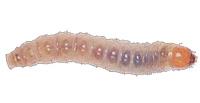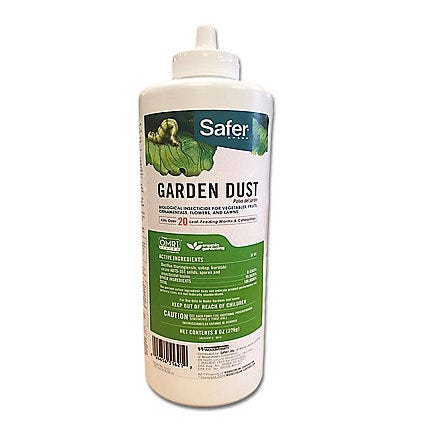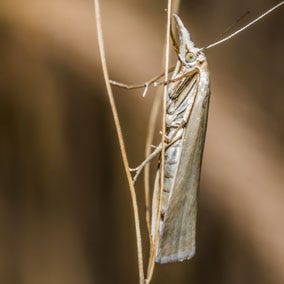
So... What are Sod Webworms?
Sod webworm is a name given to several species of caterpillars that infest lawns, golf courses, parks, cemeteries and other places with turfgrass. They get their name from their webs they create when they move, pulling together grass, soil, and plant debris.
Adults are usually cream colored and measure up to 3/4" in length. On their heads, they have two small extended points that resemble a snout, and therefore they are sometimes called "snout moths."
Sod webworm caterpillars cause the damage to turfgrass. They will reach about an inch in length and vary in color, depending on the species of caterpillar. They may be green, gray or brown, for the most part.
Reproduction Patterns of Sod Webworms
Webworm larvae overwinter in soil and when the warmth of spring arrives and grass starts to grow, the larvae begin to feed. Throughout the summer, they continue to eat and are most destructive to the grass at this point. After two months or more of feeding, they dig into the soil to pupate.

Two weeks later, they emerge as adults ready to mate and start a new generation of sod webworms.
There can be two generations in one year, with the second generation feeding in the fall. This second generation is usually not as destructive as the first since grass grows again in the fall, replenishing where they have fed.
Sod Webworm's Habitat
Found throughout the U.S. and the southern regions of Canada, sod webworms most often inhabit sunny, hot, dry areas where there is little shade.
They are most prevalent and their destruction is most evident during mid-summer. Some species will feed in the early spring and late Fall.
Symptoms of Sod Webworm Damage
Small brown spots may appear in the grass, a little at first, and then as the season progresses with rising temperatures and drier conditions, grass growth slows and the brown spots become larger and intersect. This is an indication of possible sod webworm infestation.
To confirm, move grass blades aside at the border of a patch of brown grass. You may see frass, or excrement pellets, of the sod webworm.
If still unsure, try the following procedure: Take two teaspoons of dishwashing liquid and mix with two gallons of water. Spread mixture over a two to three foot square area and wait two to five minutes. Sod webworm caterpillars will begin to emerge if they are present.
Results of Sod Webworm Infestation
Brown patches will begin to appear and will become larger and more prevalent as the infestation grows. If there is little water for the grass and it is cut very short, infestations may become even larger and more destructive.
Sod Webworm Controls
What?
B.t. Bacillus thuringiensis can be used to control new larvae. However, once damage has been noted, it's probably too late since B.t. will not work on more mature larvae.
How?
B.t., when ingested by the larva, will cause paralysis so the larva cannot eat and will starve to death. This control option can be purchased as a liquid or as a garden dust.

When?
B.t. should be applied on cloudy days or early in the morning or later in the afternoon when the sun is not as strong.
Safer® Brand offers a variety of sod webworm control products to help control and eliminate this lawn pest and revive your turfgrass. Please check out our sod webworm control products for more details about how they work and how, when, and where they should be applied.
If you are concerned about your turfgrass or unsure of how it will react to these solutions, test an inconspicuous area and wait 24 hours before applying full coverage. As a general rule, much like watering, do not use any liquid insecticides in the peak of the day or when temperatures exceed 90°F.
Why Choose a Solution?
Solutions break down quickly into their elements. They are preferable to chemical pesticides that leave residuals where they are sprayed causing long-term detrimental effects on the environment.
Natural Predators
What?
Certain beetles, the ground and rove beetles, are known predators of the sod webworm. Unfortunately, if an insecticide has been used on the turf, these insects were probably destroyed and will not be around to help control the webworms.

Parasitic nematodes have been found to help control sod webworms, particularly those that have passed the early larval stage.
How?
A day or two before planning to spread the nematodes, water the lawn and then again right before actually spreading the nematodes.
When?
Since nematodes can die in sunlight, it is wisest to spread them either early in the morning or late in the afternoon, right after watering the lawn.
Environmental Controls
What?
Watering your lawn and using fertilizer can help your lawn by keeping it healthy and strong. In addition, careful mowing may also help: do not mow closely.
Use certain turfgrasses that are resistant to sod webworm destruction. Check with your local garden center to see what varieties are best for your area.
How?
By keeping your lawn healthy and strong, any attacks by sod webworms will be less damaging. The lawn can regenerate more easily if attacked. Since webworms prefer hot, sunny and dry areas, watering in itself will help in controlling webworms.
Sod webworm resistant turfgrasses may be sown as new lawn seeding or may be incorporated into your current grass. Follow your garden center's directions or the instructions on accompanying materials.
When?
Check with your local garden center and climate zones to see when it is best to start fertilizing your lawn in the spring or to start seeding sodworm resistant grasses. Water on a regular basis, but do not over-water.

